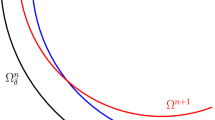Abstract
This paper is concerned with the formulation and numerical implementation of a new class of time integration schemes applied to linear heat conduction problems. The temperature field at any time level is calculated in terms of the numerical Green’s function matrix of the model problem by considering an analytical time integral equation. After spatial discretization by the finite element method, the Green’s function matrix which transfers solution from t to t + Δt is explicitly computed in nodal coordinates using efficient implicit and explicit Runge-Kutta methods. It is shown that the stability and the accuracy of the proposed method are highly improved when a sub-step procedure is used to calculate recursively the Green’s function matrix at the end of the first time step. As a result, with a suitable choice of the number of sub-steps, large time steps can be used without degenerating the numerical solution. Finally, the effectiveness of the present methodology is demonstrated by analyzing two numerical examples.
Similar content being viewed by others
References
Argyris JH, Vaz LE, Willam KJ (1977) Higher order methods for transient diffusion analysis. Comput Methods Appl Mech Eng 12: 243–278
Bathe KJ (1996) Finite element procedures. Prentice-Hall, Englewood Cliffs
Beck JV, Cole KD, Haji-Sheikh A, Litkouhi B (1992) Heat conduction using Green’s functions. Series in computational and physical processes in mechanics and thermal sciences. Hemisphere Publishing, Washington
Boyce WE, DiPrima RC (2001) Elementary differential equations and boundary value problems, 7th edn. Wiley, New York
Carslaw HS, Jaeger JC (1959) Conduction of heat in solids, 2rd edn. Oxford University Press, Oxford
Fung TC (1999) Higher-order accurate least-squares methods for first-order initial value problems. Int J Numer Methods Eng 45: 77–99
Golub GH, Van Loan CF (1996) Matrix computations, 3rd edn. The Johns Hopkins University Press, Baltimore
Hairer E, Norsett SP, Wanner G (1987) Solving ordinary differential equations I. Springer, Berlin
Hairer E, Wanner G (1991) Solving ordinary differential equations II. Springer, Berlin
Hughes TJR (1987) The finite element method: linear static and dynamic finite element analysis. Prentice-Hall, Englewood Cliffs
Kujawski J, Wiberg NE (1987) Least-squares schemes for time integration of thermal problems. Int J Numer Methods Eng 24: 159–175
Leung AYT (1985) Structural response to exponentially varying harmonic excitations. Earthq Eng Struct Dyn 13: 677–681
Leung AYT (1986) Steady state response of undamped systems to excitations expressed as polynomials in time. J Sound vib 106: 145–151
Loureiro FS (2007) Time integration methods based on the calculation of numerical Green’s functions by the finite element method (in Portuguese). Master’s Thesis, UFRJ-COPPE, Rio de Janeiro, RJ, Brazil
Mancuso M, Ubertini F, Momanyi FX (2000) Time continuous Galerkin methods for linear heat conduction problems. Comput Methods Appl Mech Eng 189: 91–106
Mancuso M, Ubertini F (2002) The Nørsett time integration methodology for finite element transient analysis. Comput Methods Appl Mech Eng 191: 3297–3327
Mansur WJ (1983) A time-stepping technique to solve wave propagation problems using the boundary element method. Ph.D. Thesis, University of Southampton, England
Mansur WJ, Loureiro FS, Soares D Jr, Dors C (2007) Explicit time-domain approaches based on numerical Green’s functions computed by finite differences—the ExGA family. J Comput Phys 227: 851–870
Mansur WJ, Vasconcellos CAB, Zambrozuski NJM, Rotunno Filho OC (2009) Numerical solution for linear transient heat conduction using an explicit Green’s approach. Int J Heat Mass Transf 52: 694–701
Moller PW (1993) High-order hierarchical A- and L-stable integration methods. Int J Numer Methods Eng 36: 2607–2624
Ozisik MN (1993) Heat conduction, 2nd edn. Wiley, New York
Soares D Jr, Mansur WJ (2004) A time domain FEM approach based on implicit Green’s functions for nonlinear dynamic analysis. Int J Numer Methods Eng 62: 664–681
Tamma KK, Zhou X, Sha D (2000) The time dimension: a theory towards the evolution, classification, characterization and design of computational algorithms for transient/dynamic applications. Arch Comput Methods Eng 7: 67–286
Vasconcellos CAB (2008) Groundwater modeling using explicit Green approach and the finite element method (in Portuguese). Ph.D. Thesis, UFRJ-COPPE, Rio de Janeiro, RJ, Brazil
Wood WL (1990) Practical time-stepping schemes. Clarendon Press, Oxford
Wood WL, Lewis RW (1975) A comparison of time marching schemes for the transient heat conduction equation. Int J Numer Methods Eng 9: 679–689
Wrobel LC (1981) Potential and viscous flow problems using the boundary element method. Ph.D. Thesis, University of Southampton, England
Wrobel LC (2002) The boundary element method: applications in thermo-fluids and acoustics. Wiley, England
Zhou X, Tamma KK (2004) A new unified theory underlying time dependent linear first-order systems: a prelude to algorithms by design. Int J Numer Methods Eng 60: 1699–1740
Zienkiewicz OC, Taylor RL, Zhu JZ (2005) The finite element method its basis and fundamentals, 6th edn. Butterworth-Heinemann, Oxford
Author information
Authors and Affiliations
Corresponding author
Rights and permissions
About this article
Cite this article
Loureiro, F.S., Mansur, W.J. A new family of time integration methods for heat conduction problems using numerical green’s functions. Comput Mech 44, 519–531 (2009). https://doi.org/10.1007/s00466-009-0389-0
Received:
Accepted:
Published:
Issue Date:
DOI: https://doi.org/10.1007/s00466-009-0389-0




